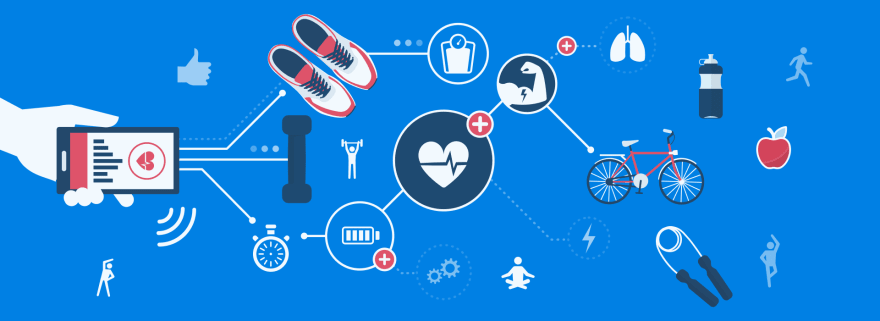Fitness applications are gaining traction as more and more brands invest in mobile and web development. Creating a fitness app gives your business a powerful competitive edge.
If you are in doubts to create a fitness app or not, then think no more.
Last year health and fitness apps were in the 8th place among the most popular apps in the Apple App Store with 3.01% of the market share (Statista Survey, 2018)
Health and fitness apps were in 11th place with 2.94% of the market share in Google Play (Statista Survey, 2018)
It is expected that the global fitness app market size will reach over $14.7 billion by 2026 (Polaris Market Research, 2018)
According to health and fitness app statistics, users are loyal to their favorite apps. About 96% use only one fitness app. More than 75% of active users open their apps at least two times a week. Also, 25% of users open health or fitness apps more than 10 times a week (Flurry Analytics Survey, 2017).
Fitness applications are becoming very popular and more and more brands invest in mobile and web development.
If you are still in two minds about building a fitness app then continue reading.
The Most Popular Types of Fitness Apps
The following fitness app ideas should be considered:
- Workout or exercise apps
Mostly users of mobile fitness apps use them to track workouts and weight loss. These apps usually make 73% of all health and fitness app sessions. If they are combined with fitness wearables, they can act like custom workout apps. They also can give recommendations for building fitness programs, which are based on the collected activity and health data.
The workout app category has a few sub-categories:
- Exercise apps
- On-demand personal trainer apps
- Yoga and gym fitness apps
- Apps to plan workout
There are many apps like these, but the most popular of them provide a unique user experience.
Freeletics gives personalized AI-based recommendations for workouts and nutrition based on your fitness goals, age, weight, height, etc.
Nike Training Club has many workouts which focus on strength, endurance, and mobility. Many filters make it easier to find workout categories.
- Activity tracking apps
This kind of app gathers data about users’ activity including solutions for running and cycling; they track steps taken, distance covered, and other fitness metrics. Such apps provide users with easy-to-understand charts and demonstrate the overall daily, weekly, and monthly activity.
Usually, physical activity tracker apps are integrated with wearable devices they can pull the useful information from.
They have a number of sub-categories:
- Running trackers
- Cycling apps
- Activity trackers
The most popular sports activities are running and jogging. Only in the USA, almost 60 million people practice running, jogging, and trail running. This is a very competitive area which offers unlimited opportunities to entrepreneurs, businesses, and the app development companies they hire.
Such running fitness apps rely on GPS in order to track covered distance, speed, and elevation. They can be compatible with wearables, such as fitness trackers and smartwatches.
The best example of this type of app is Strava, which is also used for cycling tracking. This fitness app has gotten more than 10 million downloads all over the world. This is the best social fitness app where users are able to share their achievements, motivate each other, join clubs, and monitor their friends’ progress in running and cycling.
Other examples of the best fitness applications are Runkeeper, Runtastic, and Nike+ Running.
- Nutrition apps
They are top-rated because almost 26 percent of users age 18 to 29 (Statista Survey, 2017) use them. Nutrition apps help users gain or lose weight and better control healthy eating habits.
There are a lot of examples of nutrition apps, including popular names like MyFitnessPal and Lose It!
How to Make a Fitness App: Features
The best fitness tracker apps are rich in features. While creating a fitness app, there are certain features you can’t go without. Read on to learn about them in detail.
Core Features Used to Create a Fitness App
- User account & login
User account and login is a must-have feature on your list. If users can’t view personal achievements in retrospect and compare them, then fitness and nutrition apps are useless. A user account can store data, not only on user’s devices, but also in the cloud.
Make it possible for users to register and login through social networks like Facebook, Twitter, Instagram, etc, and sign up via email. If you want to develop a fitness app with on-demand content or a paid subscription, then billing information and an integrated payment system should be present.
User profiles should have fields for data about age, gender, weight, and height. Don't forget to include different units of measurement for different countries, like kilograms vs. pounds, and meters vs. feet.
- Wearable connectivity
Wearables, which collect various types of data, have become an integral part of the fitness market. Use HealthKit and Google Fit APIs to access data from Apple Watch and a number of Android gadgets, when you create a fitness app.
These devices gather and store a lot of useful information you can use in your application:
- Number of steps and covered distance
- Heart rate
- Calories burned
- Type of exercises
Duration and intensity of physical exercises
Activity tracking
The biggest number of fitness apps are focused on activity tracking. They provide information about steps made, the number of calories burned, distance walked, run, or cycled, time spent on physical activity, and so on. Activity tracking can be done with the help of integral smartphone sensors or using a wearable device.
Learn more here




Top comments (0)